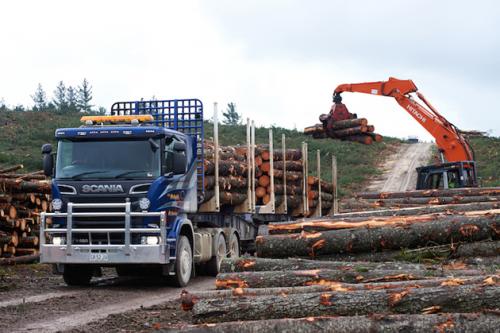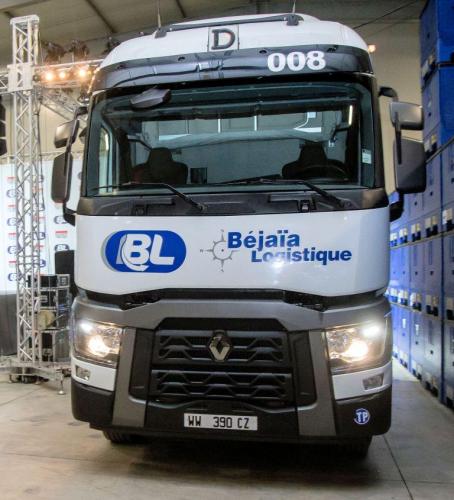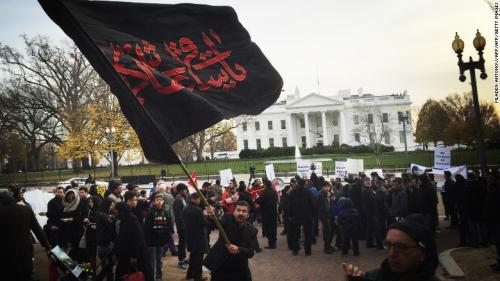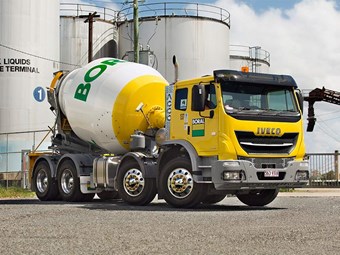
kscarbel2
Moderator-
Posts
18,892 -
Joined
-
Days Won
114
Content Type
Profiles
Forums
Gallery
Events
Blogs
BMT Wiki
Collections
Store
Everything posted by kscarbel2
-
Prime Mover Magazine / December 10, 2015 South Australia-based logging company H&L Scheidl has added a group of 620 hp Scania V8-powered prime movers to its fleet. According to H&L Scheidl, the Scania V8s have been popular with its drivers due to its comfortable cab and the Scania hydraulic retarder brake booster that provides fade-free stopping. “I found the Scania to be very comfortable. In fact, I felt fresher when I got out after the shift than when I got in. The Scania is sure-footed in the forests and gives us great traction which means more safety,” said Jim Smith, H&L Scheidl operator. Fellow H&L Scheidl driver, Dave Jones, agreed. “I have found the Scania Retarder to be absolutely brilliant. I pretty much only touch the service brakes right at the end of the braking cycle. I’m using the Retarder for about 85 per cent of the braking, and it really does make life easier especially on the fatigue side,” he said. “Another Scania benefit is the visibility. Compared to a bonneted truck, the Scania has a really wide windscreen and none of those air cleaners or stacks intrudes into your vision, and it does make a big difference, especially in the forest, and at night, as well. The truck also has a really tight turning circle, too.” According to H&L Scheidl, the 620 hp Scania V8 prime movers are being used to tow 44-tonnes of logs on Elphinstone designed and built logging trailers. .
-
California mother tortures, murders daughter, abuses 4 other children Associated Press / December 9, 2015 Authorities have charged 42-year-old Amy Chavoya of Madera Ranchos with torturing and killing her daughter, and with abusing four other children in her home. Sheriff's deputies arrested her last month after a yearlong investigation. The documents describe horrific acts against the little girl who died and other children who were in the suspect's care. Prosecutors say the abuse went on for several years. The allegations in the complaint against Chavoya are chilling. Prosecutors say she began abusing Mariah Flores back in 2011 by beating the little girl, depriving her of food, forcing her to take scalding hot showers and using a stun gun. Then on October 10, 2014, Chavoya murdered her daughter in a way that involved torture. The girl was about 12 when she died. Chavoya abused four other children over the past four years, including a boy who was stabbed and forced to eat dishwasher soap pods. According to the suspect's Instagram page, she adopted at least three of the children after being their foster parent. Chavoya's husband is allegedly a deputy sheriff. Chavoya is being held without bail and is scheduled to appear in court for a preliminary hearing on Friday. .
-
Renault Trucks Press Release / December 9, 2015 Renault Trucks Algeria has scored a 159 tractor order from Béjaïa Logistique, a subsidiary of the IFRI Group. The customer has been presented with the keys to 94 Range C 440-horsepower 4x2 tractors, and will receive another 65 units in January 2016. Designed for markets outside Europe, the Renault Trucks C features a reinforced chassis and suspension adapted for the operating conditions found in the countries concerned. At the same time, it offers an “on road” type cab offering all the comfort needed for long-distance transport. The modular design of the C range makes it possible to meet every kind of need long-distance haulage customers may encounter. This series has been designed to offer users the perfect balance between low fuel consumption, on-board comfort and safety. Thanks to the new cab’s aerodynamic form, developed and tested in a wind tunnel, this range is particularly efficient in terms of fuel consumption and energy efficiency. The Renault Trucks C vehicles delivered to Béjaïa Logistique are all equipped with Optidriver automated manual transmissions (AMT). .
-
14 people murdered in California shooting, 17 injured (updated)
kscarbel2 replied to kscarbel2's topic in Odds and Ends
Associated Press / December 9, 2015 The two San Bernardino Muslim shooters were radicalized at least two years ago and had discussed jihad and martyrdom as early as 2013, one year before they married, FBI Director James Comey said Wednesday. Comey told the Senate Judiciary Committee that investigators believe that Syed Rizwan Farook and his wife, Tashfeen Malik, were radicalized even before they began their online relationship and that Malik held extremist views before she arrived in the U.S. last year. He told the panel that the two "as early as the end of 2013 were talking to each other about jihad and martyrdom before they became engaged and married and were living in the U.S." The disclosure means that Malik's radicalization had already begun when she applied for a visa to come to the U.S. to get married, and that the government's vetting process failed to detect it. Comey said he didn't know enough to say whether weaknesses in the visa process enabled her to enter the U.S. Malik came to the United States in July 2014 from Pakistan after being approved for a K-1 (fiancé) visa. Homeland Security Secretary Jeh Johnson has said the Obama administration is now reviewing the program. He refused to say what changes were being considered. Malik married Farook the following month. Farook was born in Chicago in 1987 and raised in southern California. The FBI director described the couple as an example of homegrown violent extremists who radicalized "in place," drawing a distinction between the San Bernardino attack and the one last month in Paris that officials suspect involved planning and training in Syria. Comey declined to say what role, if any, encrypted communications played in last week's massacre. Though he said the Obama administration was not seeking to address concerns over data encryption on smartphones, he said he remained concerns that criminals, terrorists and spies were using such technology to evade detection. "Increasingly, we are unable to see what they say, which gives them a tremendous advantage," he said. He said one of the gunmen in last May's shooting outside a Prophet Mohammed cartoon contest in Garland, Texas had exchanged more than 100 messages prior to the attack that investigators still had been unable to access. -------------------------------------------------------------------------------------- Christian Broadcasting Network and Regent University founder Pat Robertson denounced Islam on his “The 700 Club” program on Tuesday, calling it “a political system masquerading as a religion.” “I think what we’ve got to do in terms of Islam is identify what it is,” Robertson said on the long-running show. “Islam is a political system that is intent on world domination. It isn’t a quote, religion, as such; it’s a political system masquerading as a religion.” -
Bronx man rapes 6-year-old girl NBC New York / December 8, 2015 A 35-year-old man has been sentenced to 25 years to life in prison for raping his girlfriend's 6-year-old daughter in the Bronx. The crime was discovered when the victim's mother went through his cellphone and saw he had videotaped the attack, according to prosecutors. Virgilio Ocampo was found guilty Tuesday of predatory sexual assault against a child and use of a child in a sexual performance following a three-week trial. Prosecutors said Ocampo and the child's mother had been dating for two years at the time of the attack and he had been staying in the mother's apartment several days a week. In January 2014, the mother looked through Ocampo's phone while he was sleeping and saw a video date-stamped from the month before showing Ocampo having sex with her daughter. That day, she reported the attack to police, but by that time Ocampo had already left the apartment. Ocampo fled to Louisiana, where police took him into custody 10 days later. Ocampo admitted to police that he sexually assaulted the victim on the day he created the video, as well as on other occasions. The victim, who is now 8, has been in and out of psychiatric facilities since the attack and is suicidal, Justice Margaret Clancy said before the sentencing. The child has been diagnosed with PTSD and other psychiatric conditions as a result of the rape. “Your Honor, this man does not deserve to ever walk these streets after all the pain he has caused my daughter, my little angel. He is a sick man and is a danger to women and children he would ever come in contact with," the mother's statement said. "This monster took a 6-year-old and raped her continuously. He videotaped it so he can watch it over and over again. He is disgusting. Hell is not even worthy of him." Judge Margaret Clancy sentenced Ocampo to the maximum extent of the law. In doing so, she said it was horrifying to witness the man rape the child on videotape and said he has shown no remorse. .
-
Why are people protesting across the street from the White House with Arabic language flags? (English is the language of the United States) .
-
You're right Tim, the 90s vintage were the definitive F-Series. And that one is cherry.
-
Ex-Australia PM Tony Abbott says Islam must reform BBC / December 8, 2015 Former Australian Prime Minister Tony Abbott has sparked criticism by saying Islam has a "massive problem" and needs to reform. Writing in Australian media, Mr Abbott said "not all cultures are equal" and the West should stop apologizing for defending its values. Opposition leader Bill Shorten said the comments were "counterproductive". [shorten believes speaking in terms of reality is counterproductive] Current Prime Minister Malcolm Turnbull said the vast majority of Muslims were "appalled" by extremism. [Turnbull lives in a dream world] Turnbull said it was "absolutely vital to ensure that we don't make the mistake, which is what the terrorists want us to do, of tagging every single Muslim with the responsibility for the crimes of the few". While it was "no revelation" that there were violent elements in the Muslim world, the religion is compatible with democracy and an open society, he said, and most victims of extremist groups are Muslims. Turnbull said his comments on extremism were always "carefully calculated" to "make Australia safer and to make the work of our security services less difficult than it already is". Abbott was removed as prime minister by a party vote in September amid poor poll ratings and is now a backbench MP. Before his political career he had trained to be a Catholic priest. Abbott’s letter cautioned against "demonizing" Muslims, but said the West "can't remain in denial about the massive problem within Islam". "Although most Muslims utterly reject terrorism, some are all too ready to justify 'death to the infidel'," Abbott said. "Islam never had its own version of the Reformation and the Enlightenment or a consequent acceptance of pluralism and the separation of church and state. "It's not culturally insensitive to demand loyalty to Australia and respect for Western civilisation. Cultures are not all equal. "We should be ready to proclaim the clear superiority of our culture to one that justifies killing people in the name of God." Abbott also said only Muslims could tackle supporters of violent extremism, and that "everyone interested in a safer world should be reaching out to 'live and let live' Muslims and encouraging them to reclaim their faith from the zealots". Nail Aykan, executive director of Islamic Council Victoria, told the BBC Mr Abbott's comments were "completely unhelpful at a time when we are trying to foster unity and social cohesion in Australian society". He advised Mr Abbott to "go out and meet some real local Muslims and get their perspective before you start patronising a whole population".
-
Kiwi Titan pure porn
kscarbel2 replied to mrsmackpaul's topic in Modern Mack Truck General Discussion
But it's just not the same without that yank Maikshilo behind the wheel.- 1 reply
-
- 1
-

-
Death sentence upheld for 'torture' murder of 2-year-old boy December 3, 2015 The Pennsylvania State Supreme Court on Thursday upheld the death sentence for a York County man convicted of murdering a 2-year-old boy he was baby-sitting. A county jury found Aric Shayne Woodard, now 42, guilty of first-degree murder in 2013 for the slaying of Jaques Twinn. Woodard beat the child to death in November 2011 in a home in York. Woodard said he hit the boy after finding him smearing himself with feces, then ordered him upstairs to clean up. Police responded to a 911 call and found the toddler in cardiac arrest. Woodard was holding the child, who was wet, naked and smelled of feces. Investigators concluded Woodard had hit the boy so hard in the abdomen that the child's liver was lacerated. The multiple injuries Jaques suffered showed the child was tortured. "There is sufficient evidence...to conclude that (Woodard) intentionally inflicted a considerable amount of pain and suffering upon Jaques that was unnecessarily heinous, atrocious or cruel, manifesting exceptional depravity beyond a mere intent to kill," Justice Max Baer wrote. .
-
Murder an innocent toddler and you only get charged with child endangerment...........go figure. Until confirmed murderers (indisputable situations) are summarily executed, we will continue see our crime rate soar, and the health of American society plummet. -------------------------------------------------------------------------------------------------------- Chicago mother beats 2-year-old toddler to death Associated Press / December 2, 2015 An 18-year-old pregnant woman whose toddler was temporarily taken away last year by the Illinois Department of Children and Family Services was (only) charged with child endangerment after she beat the girl so badly for not eating her lunch that she died over Thanksgiving weekend. Jazmine Jones punched 2-year-old Elliana Claiborne multiple times in the stomach and buttocks on November 28. Jones later admitted to authorities that she hit the child. Jones then left the child at the home of her boyfriend where she was residing, to go buy marijuana. The boyfriend is not the biological father of the child. Often, depending how frustrated she was, Jones would punch the girl, prosecutors said. Jones has had many prior contacts with DCFS, according to prosecutors. Last year Elliana was taken into DCFS custody after Jones threw her off a balcony, causing her to land on snow-covered cement below, said Assistant Cook County State’s Attorney Kim Przekota. Last weekend, when Jones returned to her boyfriend’s home after buying pot, she gave the toddler laxatives and juice because the child appeared sick, couldn’t use the bathroom, had a swollen stomach and complained about stomach pain, Przekota said. Later that evening, the boyfriend’s mother heard the child fall down the stairs and suggested the child be taken to the hospital. The mother ignored the advice. In the middle of the night, Elliana moaned about her stomach and threw up a greenish liquid. The boyfriend’s sister put Elliana back to bed but noticed that the child was lying with her eyes opened. The next morning, a family member went to wake the child and found that she had soiled herself and was “cold and stiff.” The boyfriend allegedly tried to perform CPR on the child and a yellowish liquid came out of the girl’s mouth. Jones and the boyfriend took the child’s body to St. Bernard Hospital where she was pronounced deceased. According to the Cook County Medical Examiner’s Office, Elliana died of multiple blunt force trauma, specifically injuries caused by a direct blow to the abdomen, not by a fall down the stairs or an accident. Elliana also suffered bruises on her head, abdomen, face, back and arms. She had healing burns on a foot, healed scars and two rib fractures. Judge Laura Sullivan ordered Jones held on $1 million bail. .
-
Oklahoma man sexually abuses, murders 1-year-old girl Reuters / December 7, 2015 An Oklahoma man has been arrested on a murder charge for beating and sexually abused the 1-year-old daughter of his girlfriend. Cody Johnson, 30, and his girlfriend brought an unresponsive Sawyer Paige Jefferson to a Tulsa hospital on Saturday, claiming that the girl had tripped over her pajamas and fallen on a toy. The little girl was in cardiac arrest and unresponsive. Doctors found the girl had "numerous visible facial contusions and bruising and bleeding coming from both the child's vagina and rectum." The baby was placed on life support, but she never regained consciousness. She was pronounced dead a short time later. Johnson was arrested on Sunday on charges of first-degree murder of a minor, child abuse and sexual abuse of a minor. As of Monday morning, Johnson was in the Tulsa County Jail. Bond has been set at $100,000 for the two abuse complaints with no bond given for the murder complaint. .
-
Since acquiring Mack Trucks, Volvo has continually forgotten how they got to the party. The Mack customer base was loyal, unlike ordinary customers which switched brands like socks as they purchased that day's lowest price truck. Volvo has been entirely focused on melding Mack into the Volvo empire (changing the Mack truck into a superior Volvo). Unlike Renault, Volvo never had any interest in understanding and appreciating Mack Trucks for what it was. To Volvo, buying Mack was but a means to an end.
-
With all due respect (we're friends), I still see rust from bumper to taillamps on all the new Mack trucks at the dealers. A PDI can't correct the situation that the chassis was not primed before it was "cheaply) painted. And the newer trucks are frequently in the shop, translating to well over 75 percent of their activity being warranty repairs. Today's Mack is not the product of 20 years ago. It has evolved into a cheap disposable truck. This all goes back to an old topic............http://www.bigmacktrucks.com/index.php?/topic/2094-is-volvo-good-or-bad-for-mack-trucks/page-8
-
Paccar Press Release / December 9, 2015 Paccar’s board of directors today declared an extra cash dividend in the amount of one dollar ($1.00) per share, payable on January 6, 2015, to stockholders of record at the close of business on December 19, 2014. The board of directors also declared a regular quarterly cash dividend in the amount of twenty-two cents ($.22) per share, payable on March 5, 2015, to stockholders of record at the close of business on February 13, 2015. Mark Pigott, executive chairman, shared, “Paccar’s excellent profits and strong cash flow have enabled the company to invest in new innovative quality vehicles, expand its aftermarket distribution centers and enhance its production facilities.” “Paccar’s results reflect strong truck sales in the U.S. and Canada, and excellent aftermarket parts and financial services results worldwide,” said CEO Ron Armstrong. “Paccar’s North American customers are benefiting from good economic growth, record freight tonnage, lower fuel prices, and the excellent operating efficiency of our industry-leading Kenworth and Peterbilt trucks. Kenworth and Peterbilt U.S. and Canada Class 8 truck orders through November were 46 percent higher compared with the same period last year. U.S. and Canada Class 8 truck industry retail sales this year are expected to be the highest since 2006.”
-
DAF Trucks Press Release / December 8, 2015
-
Transport Topics / December 8, 2015 The Department of Energy said it expects the price of diesel to average $2.67 a gallon in 2016 and gasoline to average $2.36. Trucking’s main fuel is expected to average $2.71 a gallon this year, $1.12 lower than the 2014 average, DOE’s Energy Information Administration said in its monthly short-term energy outlook released Dec. 8. “After paying the lowest Thanksgiving gasoline prices in seven years, U.S. drivers will continue to save money at the pump through December as low crude oil prices keep downward pressure on motor fuel costs,” EIA said in a statement. Consumption of distillate fuel, which includes diesel fuel and heating oil, is expected by EIA to rise 1%, or 40,000 barrels a day in 2016, driven by increases in manufacturing output, foreign trade and marine fuel use. EIA said Brent crude oil prices are forecast to average $56 a barrel in 2016 and for West Texas Intermediate crude oil prices to average $51 a barrel. “While U.S. monthly onshore oil production is expected to continue declining through most of next year, oil output in the Gulf of Mexico is on track to steadily rise,” EIA said. “Energy companies have cut back on their onshore oil exploration and drilling activities in response to low crude prices, but oil production in the Gulf of Mexico is less sensitive to short-term movements in crude prices as companies are committed to completing more complex and costly offshore oil projects once they begin,” according to EIA. U.S. average diesel prices are at the lowest level in 6 1/2 years at $2.379 a gallon, Department of Energy reported Dec. 7. The latest decline left diesel just 2.5 cents above the U.S. average retail price of $2.354 on June 1, 2009. Diesel is $1.156 lower than it was a year prior after the fourth consecutive weekly decline. The national average price of gasoline fell six-tenths of a cent to $2.053 a gallon as prices dropped in all regions except the Midwest, where it rose 1.3 cents to $1.890. “Local fueling stations in some areas of the country are already selling gasoline for less than $2 a gallon, and those prices are expected to drop further in December,” EIA said.
-
"People should and do trust me" - Hillary Clinton
kscarbel2 replied to kscarbel2's topic in Odds and Ends
How many here have followed the news on Hillary Clinton’s former top aid and confidant Huma Abedin, who is now Clinton’s presidential campaign vice chair person? Huma Abedin has faced massive scrutiny (conflict of interest charges) over her work as a consultant for outside clients while simultaneously serving at the State Department. https://www.washingtonpost.com/politics/how-huma-abedin-operated-at-the-center-of-the-clinton-universe/2015/08/27/cd099eee-4b32-11e5-902f-39e9219e574b_story.html http://www.nytimes.com/2013/08/19/nyregion/questions-on-the-dual-role-of-a-clinton-aide-persist.html?_r=1 On another note, Huma Abedin, the longtime confidant to Democratic presidential front-runner Hillary Clinton, took aim at Donald Trump’s proposal to ban Muslims from entering the United States in an email saying “I’m a proud Muslim.” Why she remains married to Anthony Weiner raises many questions (https://en.wikipedia.org/wiki/Anthony_Weiner_sexting_scandals). -
Yesterday, house speaker Paul Ryan (R-WI) said: “Some of our best and biggest allies in this struggle and fight against radical Islam terror are Muslims.” And that would be who?
-
Russia has, for the first time, hit ISIS targets in Syria with Kalibr land-attack cruise missiles launched from a submarine in the Mediterranean Sea. The 3M-54 Kalibr missiles were launched from the Kilo-class diesel-electric submarine “Rostov-on-Don”. Russian warships based in the Caspian and Mediterranean seas launched similar cruise missiles strikes on ISIS positions in late November, but this is the first time that Russia has targeted ISIS from a submarine. “[The missiles] targeted two major terrorist positions in the territory of Raqqa,” Defense Minister Sergey Shoigu said. “We can say with absolute confidence that significant damage has been inflicted upon ammunition warehouses and a mine production plant, as well as the oil infrastructure.” Pentagon spokesman Peter Cook said: "We were given advanced notice that they would be carrying out strikes." He added: "We appreciate that," particularly because the Kremlin was not required to do so under a memorandum of understanding signed by Russia and the US to avoid the two sides clashing over Syria. The advanced notice on the cruise missiles was "an additional measure of safety," said Cook. Russia has ratcheted up airstrikes.
-
In the wake of Donald Trump’s proposal to ban Muslims from entering the U.S., Senator Rand Paul, R-Ky., said yesterday: “I think stricter scrutiny is a good idea.” Paul disagrees with having a religious test. “But I think if we want to say there is no religious aspect to this war, I think that’s a big mistake.” “I think there are a lot of people hell-bent on attacking us, and we do have to review who is coming, and how many people come, and where they come from,” said Paul. “I’m no big fan of Donald Trump. … But I also think it’s unfair to say he’s the biggest recruiter for ISIS.” Paul sponsored the Stop Extremists Coming Under Refugee Entry (SECURE) Act, which called for a pause on immigration from 34 countries he says have a “high risk” of terrorism. Fellow presidential candidate Sen. Ted Cruz, R-Texas, voted for the act. Sen. Marco Rubio, R-Fla., voted against it, and it failed 10-89 on Dec. 3. “Right now, all of Europe can come and visit our country with no visa,” said Paul. “I think that’s a recipe for disaster and we are eventually going to be attacked by people who come from Europe. Why? Because Europe has a significant population now of those who believe that violence is justified.” Paul said he would still begrudgingly support Trump if he becomes the Republican nominee. “I won’t be enthusiastic about it, I won’t be excited about it, but what I have said is I will support the nominee.” Paul blamed the media, polling and debates for Trump’s lead in the GOP race. “Really we have nobody to blame but ourselves if this ends up happening, that he is the nominee.”
-
Government response time........slow as molasses --------------------------------------------------------------------------- House tightens controls on visa-free travel to US Associated Press / December 8, 2015 The House has approved legislation tightening controls on travel to the U.S. and requiring visas for anyone who's been in Iraq or Syria in the previous five years. (Of course it still needs to to go to the Senate and be signed by the President. Perhaps in five years they’ll have it done. The program should have been suspended after 911, much less within 48 hours of the Paris attack) The bill was approved 407-19. It takes aim at the "visa waiver" program, which allows citizens of 38 countries to travel to the U.S. without first obtaining a visa. Belgium and France, home to most of the perpetrators of the Paris attacks, are among the participating countries. The Syrian refugee bill, which the administration said was unnecessary because the small number of Syrian refugees are (allegedly) extensively screened, has not gone anywhere in the Senate and looks unlikely to advance. The visa waivers bill, on the other hand, may be added to a must-pass year-end spending bill now being finalized on Capitol Hill. There is a different version in the Senate by Democrat Dianne Feinstein of California and Republican Jeff Flake of Arizona. The travel industry, which backs the House bill as a balanced approach, says the Senate bill goes too far in adding new biometric requirements for all visa waiver travelers that might be difficult to enact. (There you go.....the needs of the travel industry outweigh all else) The legislation would institute a series of changes, including the new visa requirement for citizens of Iraq, Syria and other countries that are home to extremist groups or anyone who's traveled to those countries in the previous five years. Countries in the visa waiver program would also be required to share information on extremists with the U.S. and face expulsion from the program if they don't (good luck with that). "You have more than 5,000 individuals that have Western passports in this program that have gone to Iraq or Syria in the last five years," said Majority Leader Kevin McCarthy. "Those are gaps that we need to fix." (so why did it take congress 5 years and a Paris attack to address it?) Some 20 million “visitors” come to the U.S. annually under the visa waiver program. They are screened through an online system maintained by the Department of Homeland Security. But in past years, the (open door policy) program has been used by would-be terrorists, including "shoe bomber" Richard Reid, who boarded a flight from Paris to Miami in December 2001 without a visa and attempted to set off a bomb. Zacarias Moussaoui, the "20th hijacker" from 9/11, also flew from London to Chicago with a French passport and no visa in February 2001. A handful of Democratic lawmakers spoke against the visa waiver legislation before its passage. Rep. Keith Ellison, D-Minn., said the bill is overbroad in stripping visa waiver privileges from all Syrian and Iraqi nationals and said it should include more exceptions for more people, such as journalists and researchers. "Our focus should be on terrorism, not just country or origin," Ellison said. Separately some lawmakers are also talking about looking at the fiancé visa program utilized by the shooters in San Bernardino, California. That program is already being reviewed by the Homeland Security Department.
-
Greycart celebrates 25 years operating with ACCO trucks Ausralian Earthmoving / November 18, 2014 The Australian-designed and built ACCO range of trucks has been an integral part of the Australian transport industry since its introduction in the 1960s. Engineered to meet local climatic conditions and stand up to some of the harshest driving conditions in the world, the ACCO is produced at the same manufacturing facility in Dandenong, Victoria where it was born. The iconic truck has become the de facto platform for the vocational market, such as concrete mixers and garbage collection, throughout Australia. The design combines the requirements of high body strength while preserving a light kerb weight which allows an ACCO to withstand the stresses associated with having a constantly revolving heavy load on its back while assuring the best efficiency for its payload class. Queensland-based Greycart Pty Ltd is one company that knows the capabilities of the ACCO well. Ross Books, owner and Managing Director of Greycart, said that his company uses the eight-wheel version of the ACCO with a 7.6 metre agitator on the back to deliver concrete under contract to Boral. Since buying his first ACCO truck in 1986, Books has added to Greycart’s fleet and currently has nine ACCOs driven by his ten full-time drivers. Books’ drivers deliver concrete to a wide variety of commercial and domestic construction jobs, but are also involved in large scale or unusual jobs. “Our trucks have been loaded on to barges and sailed over to Stradbroke [island] to a construction site,” Books stated. “We’ve also been to large infrastructure projects with massive ‘raft slabs’ requiring thousands of cubic metres of concrete to be laid in a single continuous pour.” Concrete is a versatile product, but as soon as the cement and water are mixed, the chemical reaction starts and there are only a few hours in which to deliver the concrete to site before it starts to harden in the truck and become unworkable. “Because of these time constraints, I need a reliable truck for delivering concrete,” Books stated. “Personally, I think that the ACCO is the best vehicle for our industry and why I decided on a common fleet,” said Books. “I did stray briefly, but the alternative was just too heavy a vehicle for the type of work we were doing.” “I like building a long-term relationship with a supplier,” Books added. “I don’t need to have the cheapest, but in this business it is important to have reliable vehicles and the ACCO has been the most reliable for me.” Books says he greatly appreciates the aftersales support Iveco Brisbane provides in keeping his fleet on the road and in more than 25 years can only recall one instance of having to deal with a major fault. Three of Greycart’s ACCOs are based in Brisbane and six are on the Gold Coast. The trucks make a large number of relatively short journeys during their working life with the company. “Most deliveries are no more than 10 kilometres, with an occasional job requiring a 100 km round trip,” Books said. “Hauling concrete is harsh on the vehicles as we clean with an acid wash,” said Books. “This is not the kindest treatment for a truck but the ACCOs stand up to it well so we only have to replace vehicles every five to seven years,” Long-term relationships also apply to the company’s drivers. Of the ten drivers employed by Greycart, most have been with the company for more than five years and the first driver Books employed 10 years ago is still with the company. Two of Books’ sons also drive for Greycart, as does one son’s fiancée. “She was thinking of changing jobs and when I said I needed another driver she said ‘What about me?’” Books stated. “She went out and got her HR licence and has been with us for 12 months now and really knows her product.” Books’ future daughter-in-law joins a growing number of women in the heavy transport industry, but even today less than five per cent of licenced truck drivers are female. While there have been recent government and industry reports warning of the increasing number of unskilled truck drivers on Australian roads, Books stated all his drivers are very conscious of the demands of their job. Controlling a vehicle with up to a 17 tonne load that is constantly moving requires specialist knowledge and additional driving skills. ”As it is rotating, the centre of gravity changes as the mix climbs the side of the bowl,” Books said. “The weight is more on the driver’s side so if you make a left-hand turn too quickly, it’s possible for the whole truck to topple over.” Iveco has introduced Electronic Stability Control (ESC) to the 8×4 ACCO, further enhancing the capability and safety of the vehicle. ESC continuously monitors steering and vehicle direction. When the system detects a probable loss of steering control it asymmetrically applies the brakes to individual wheels. A unique feature of the innovative but functional design of the ACCO is that since the first prototype, every part of its cab-chassis has been manufactured at the Iveco Trucks Australia Dandenong facility. Since its introduction [under International Harvester], more than 79,000 ACCO trucks have been driven off the production line. The engine and drivetrain of the ACCO have been designed to meet the emissions requirements of the ADR 80/03 standard. The engine is one of the latest diesel designs featuring a Selective Catalytic Reduction (SCR) system, along with ABS brakes, active traction and the latest cooling system. Related reading - http://www.bigmacktrucks.com/index.php?/topic/36017-the-legendary-acco-designed-and-built-by-australians/
-
Prime Mover Magazine / December 8, 2015 Queensland-based subcontractor, Ross Books, has purchased a 2015 Iveco ACCO 8x4 agitator to service a contract with construction and building materials specialist Boral. The new ACCO agitator is the ninth Iveco vehicle to join Books’ fleet, and is the sixth to be purchased new in the last two years. “The latest trucks are as tough and reliable as the ACCO have ever been and they ride beautifully; they have air suspension, air suspended driver’s seat, air conditioning, electric mirrors and windows and Bluetooth – they’ve got all the creature comforts of a modern car – I think they’re a great truck,” said Books. The 2015 ACCO reportedly features an SCR powerplant rated at 340hp / 254kW and 1106 lb ft / 1500 Nm. The engine is coupled to an Allison six-speed automatic transmission. The load sharing, twin steer front axle and Hendrickson air suspension combination allows weight distribution for the 7.6 cm³ Cesco bowl, allowing up to 11 tonnes over the front axles. The ACCO 8x4 agitator boasts electronic stability control (ESC), which Books said is required for the Boral contract. According to Iveco, reliability was also a key consideration for Books, as concrete is a time-sensitive product, with service being judged on timely delivery and on the concrete’s ‘slump’ performance, or the measure of the consistency and workability of fresh concrete. “We carry a product that actually ages very quickly, the concrete should be out of the bowl within an hour and a half of batching. And it’s all about consistency, especially if you have a concrete pump on site doing a major pour, the concrete needs to be turning up at the right intervals. “If timing is out, it’s more difficult to blend the concrete and you can get what’s referred to as a ‘cold joint’, which can cause cracks in the finished product. While delivery and timing calculations are handled via a centralised computer system at Boral’s head office, our control in the process is to operate reliable vehicles. “The ACCOs provide great value for money and their resale value is also good, they’re a known product, they’re an industry standard.” .
BigMackTrucks.com
BigMackTrucks.com is a support forum for antique, classic and modern Mack Trucks! The forum is owned and maintained by Watt's Truck Center, Inc. an independent, full service Mack dealer. The forums are not affiliated with Mack Trucks, Inc.
Our Vendors and Advertisers
Thank you for your support!












